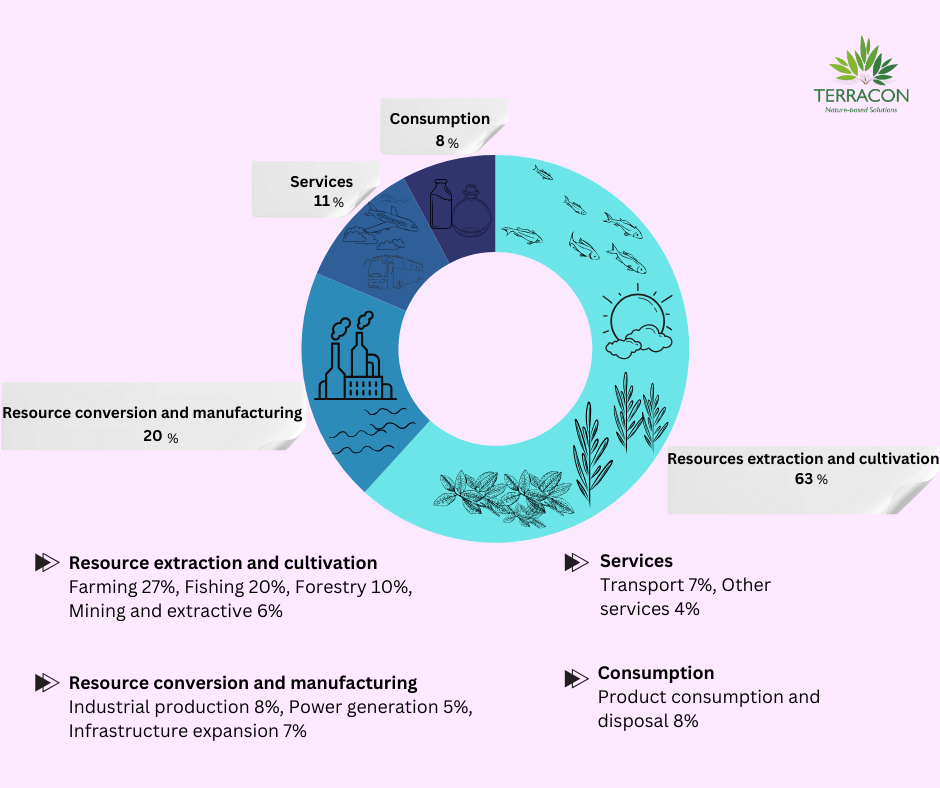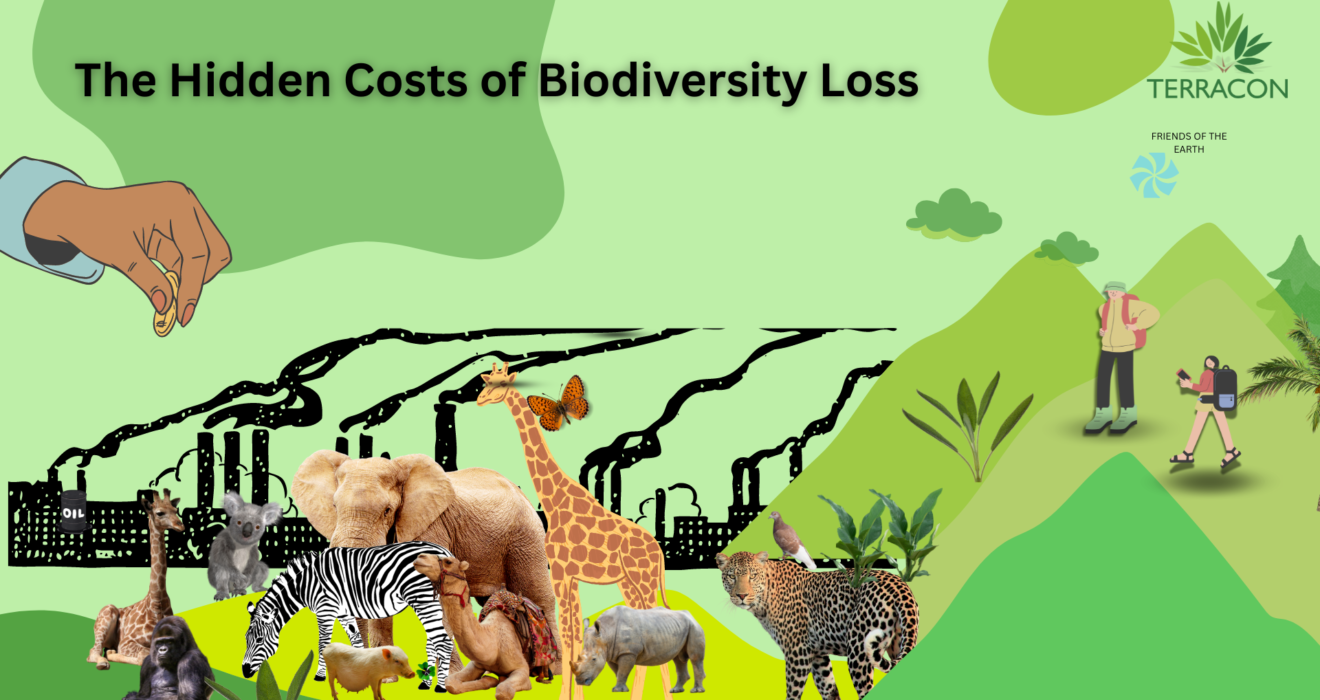Sustainability has surged to the forefront of business priorities in recent years, with numerous organizations striving to achieve net-zero carbon emissions and even become climate positive. The problems we’re dealing with go beyond just the climate emergency. There’s also a significant issue with biodiversity loss. Many plants, animals, and their habitats are at risk of disappearing forever. This is a serious crisis because biodiversity is essential for our planet’s health and our own well-being.We must reduce carbon emissions to net-zero and protect biodiversity. Doing so is crucial for a healthy, sustainable future.
Our current consumption of planetary resources is alarmingly unsustainable. Our demands are so great that according to the Global Footprint Network, we are now using those resources at almost twice the rate that the Earth can renew them. Practices like deforestation, habitat destruction, and excessive use of water and raw materials are wreaking havoc on our environment. This unsustainable consumption not only generates vast amounts of waste, further polluting our planet, but also jeopardizes the long-term viability of business operations.
Many businesses heavily depend on natural resources, often without recognizing how much these resources rely on robust, healthy ecosystems. By evaluating their biodiversity or nature footprint, businesses can identify the risks that biodiversity loss poses to their operations and work towards a nature-positive future in a comprehensive manner. Despite the clear importance, few businesses currently consider their biodiversity footprint. It’s critical for organizations to assess their broader environmental impact now, recognizing that our planet’s health directly influences the stability and success of business operations.
What is Biodiversity and Why is it Important?
Biodiversity is the variety of life on Earth, including plants, animals, fungi, and other organisms. These species are interconnected within ecosystems, forming complex relationships. Maintaining biodiversity is crucial because each organism depends on others for survival, and the loss or addition of a single species can impact the entire ecosystem.
Promoting biodiversity involves preserving and restoring natural habitats like forests and wetlands. This supports a wide range of species, ensuring ecosystem health.
The Biodiversity is a complex and intricate web of life that takes a long time to develop. In fact, it can take up to 100 years for a forest to regenerate to its original state after being destroyed.
Biodiversity is essential for ecosystem stability and productivity. Diverse ecosystems are more resilient to changes, diseases, and climate impacts. For example, marine protected areas with high biodiversity can see fishing yields increase up to five times. Ecosystem services provided by biodiversity, such as food and water, are valued at $33 trillion annually.
In short, maintaining biodiversity is vital for the sustainable use of natural resources and economic stability, ensuring a healthy and prosperous future.
Why is Biodiversity Important to Business/Industry ?
Biodiversity loss and ecosystem collapse is important to business for two main reasons – the risks that are associated with it (dependencies), and the impact of businesses upon it (responsibilities).
Dependencies
Biodiversity loss has significant economic consequences, with half of the world’s GDP, approximately $44 trillion, relying on nature. Each year, we lose ecosystem services valued at more than 10 percent of our global economic output, threatening both lives and businesses. A study by the Natural Capital Finance Alliance and the United Nations Environment Finance Initiative found that 13 out of the 18 sectors in the FTSE 100 have production processes that heavily depend on nature, accounting for $1.6 trillion in market capitalization. The link between business and nature is undeniable, making the preservation and restoration of biodiversity a critical priority. With 1 in 5 countries facing ecosystem collapse according to Swiss Re, businesses must urgently reassess the risks posed by biodiversity loss.

In industries like agriculture, the impact of biodiversity loss is evident. Reduced soil fertility due to the depletion of soil organisms, increased soil erosion from plant loss, and lower productivity due to declining pollinator populations are just a few examples. Similarly, industries such as fishing, forestry, and tourism, which directly rely on ecosystems, suffer significantly from habitat degradation, like the loss of lakes, woodlands, or coral reefs. Biodiversity is crucial for ecosystem productivity and resilience, so its decline affects the supply of essential products like timber, food, medicinal plants, and other raw materials. Additionally, ecosystem services provided by natural habitats, such as floodwater absorption or air quality improvement, can impact businesses within their catchment areas.
The risks posed by biodiversity loss can also be less apparent, especially in the realm of investments. Investors are increasingly considering a company’s sustainability profile and its long-term operational stability in relation to nature-related risks. Biodiversity loss ranks third among long-term risks identified by executives in the World Economic Forum’s Global Risk Perception Survey, following climate change inaction and extreme weather impacts. An indirect but significant risk of biodiversity and habitat loss is the emergence of new diseases, as wild animals come into closer contact with humans. The COVID-19 pandemic highlighted the severe human and economic costs of such diseases.
The investment community is becoming more aware of the importance of a business’s biodiversity profile, especially as the EU introduces mandatory reporting on biodiversity-related risks and impacts under the new Corporate Sustainability Reporting Directive. Compliance with these new regulations presents another risk that businesses must consider when planning for the future.
Responsibilities
Biodiversity loss threatens not just the environment but also the effective functioning of businesses and supply chains. Evidently, business operations are significant contributors to this problem. Companies directly impact biodiversity through overharvesting resources, sourcing raw materials from suppliers who damage natural areas, and causing habitat destruction for construction or agriculture. Indirect impacts include investing in entities that harm ecosystems. Additionally, the waste produced by businesses further damages ecosystems and needs to be addressed as part of their environmental footprint.
Awareness of the need to quantify and reduce business impacts on biodiversity is growing. Companies like Sainsbury’s, Nestlé, and H&M are advocating for mandatory nature impact disclosures by 2030 as part of the COP15 process. The new EU Corporate Sustainability Reporting Directive will require larger businesses to disclose their impact on biodiversity and ecosystems by 2024.
Between 1992 and 2014, global capital production doubled, and human capital per person increased by about 13%. However, the stock of natural capital per person declined by nearly 40%, showing that economic growth has come at the expense of nature. One of the biggest challenges in measuring our impact on nature is that our economic systems do not effectively value ecosystem services. These services, such as food production, carbon storage, and water and air filtration, contribute over $150 trillion annually to the global economy—more than twice the world’s GDP. Yet, without an effective framework to estimate this value, incorporating it into business models is difficult. Initiatives like the Taskforce on Nature-related Financial Disclosures are developing methods to assess the nature or biodiversity footprint of businesses.
Resource extraction and cultivation are major drivers of biodiversity loss. Over 90% of human pressure on biodiversity comes from four main value chains: food production (50%), infrastructure and mobility (25%), energy production (10%), and fashion (less than 10%). Other sectors, like pharmaceuticals, cosmetics, and consumer electronics, have a lower impact but still face significant risks from biodiversity loss. Business operations impacting ecosystems can lead to reputational damage, legal actions, and reduced investment due to negative biodiversity impacts.
Consider the textile industry as an example. A textile producer using natural fibers impacts ecosystems directly through land conversion for crops. Textile production requires water and can contribute to water pollution from pesticide and herbicide runoff. Greenhouse gas emissions from this process add to air pollution and climate change. The production of fertilizers, herbicides, and pesticides for crop production has upstream negative impacts on ecosystems. Downstream effects include impacts from shipping, packaging, and storage. These cumulative effects, especially on air and water pollution, pose risks of fines, reputational damage, and loss of productivity due to reduced ecosystem resilience.

By understanding and mitigating their biodiversity impacts, businesses can not only help protect the environment but also ensure their own long-term viability and success.
Is there still time to repair Earth’s biodiversity ?
The intricate dance between biodiversity and business is revolutionizing the way industries approach growth and sustainability. Today, 40,000 species of plants and animals are used daily by humans worldwide, and close to 40 percent of pharmaceuticals in the United States are derived from natural compounds found in living organisms.
As the global community acknowledges the value of biodiversity as a cornerstone of economic prosperity, businesses must become critical stakeholders in preserving Earth’s rich tapestry of life. The journey towards a harmonious coexistence between economic development and environmental conservation is rife with challenges, but also laden with opportunities for innovation and collaboration. By embracing sustainable practices, adopting green technologies, and actively engaging in conservation efforts, businesses can play an instrumental role in preserving biodiversity. In fact, scientists estimate that upwards of 10 million – and possibly more than 100 million – different species inhabit the Earth, and three species go extinct every hour due to human activities. By working together, we can forge a sustainable future that balances economic growth with environmental conservation.

Written by
Anjeeta Goud
Team Business Development and Strategy
Terracon Ecotech
Reference :
https://www.bcg.com/publications/2021/biodiversity-loss-business-implications-responses
https://forestsclearance.nic.in/DownloadPdfFile.aspx?FileName=1111112461216M3AIEbio.pdf&FilePath=../writereaddata/wildlife/Userdetail/
https://portals.iucn.org/library/sitecs/library/files/documents/Rep-2000-055.pdf
https://www.researchgate.net/publication/341607127_What_is_Biodiversity_assessment_Definition




